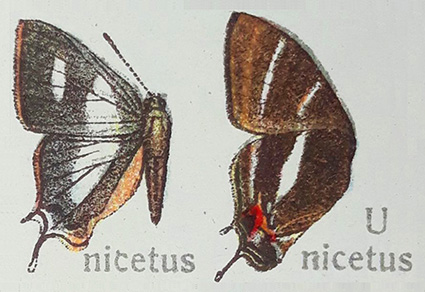Abstract
Lamprospilus stegmaier Prieto & Faynel sp. nov. is described from five specimens collected in sympatry with L. nicetus C. Felder & R. Felder on the northern central range of the Colombian Andes. Lamprospilus bicolor Faynel & Prieto sp. nov. is described from specimens collected in Colombia, Peru and Bolivia. Lamprospilus bicolor mirador Faynel & Prieto ssp. nov. is described from specimens collected in Peru and Bolivia. Lamprospilus decorata valluna Prieto & Faynel ssp. nov. is described from specimens collected in Western Colombia. Male and female phenotypes are associated, and we present morphological and molecular diagnostic characters for the new species. We also evaluate the congruence between a priori morphology-based species identifications and Molecular Operational Taxonomic Units (MOTUs) delimitations based on Barcode Index Numbers (BINs) in the genus. DNA barcodes are in perfect agreement with morphology in 64% of the species. Interspecific distances were found to range from 3.22% to 8.42% (average 5.48%), whilst their mean intraspecific variation ranges from 0.0% to 4.30% (average 1.78%). Based on DNA barcodes evidence of topotypic individuals, the study of original descriptions and illustrations of the holotypes, we consider here that Lamprospilus occidentalis Johnson & Salazar 2004 is a new junior subjective synonym of L. draudti Lathy, 1932.
References
Costa, M., Viloria, A.L., Attal, S., Benmesbah, M., Fratello, S. & Bálint, Z. (2019) Lepidoptera from the Pantepui. Part VII. A distinctive Lamprospilus species from the Guiana Highlands (Lepidoptera: Lycaenidae: Theclinae). Opuscula Zoologica (Budapest), 50 (2), 111–128. https://doi.org/10.18348/opzool.2019.2.111
deWaard, J.R., Ivanova, N.V., Hajibabaei, M. & Hebert, P.D.N. (2008) Assembling DNA barcodes: analytical protocols. In: Martin, C. (Ed.), Methods in molecular biology: environmental genetics. Humana Press Inc, Totowa, New Jersey, pp. 275–293. https://doi.org/10.1007/978-1-59745-548-0_15
Draudt, M. (1919–1920) Familie: Lycaenidae. In: Seitz, A. (Ed.), Die Gross-Schmetterlinge der Erde. Vol. 5. Alfred Kernen, Stuttgart, pp. 769–824, pls. 144–159.
Duarte, M. & Robbins, R.K. (2010) Description and phylogenetic analysis of the Calycopidina (Lepidoptera, Lycaenidae, Theclinae, Eumaeini): a subtribe of detritivores. Revista Brasileira de Entomologia, 54 (1), 45–65. https://doi.org/10.1590/S0085-56262010000100006
Edgar, R.C. (2004) MUSCLE: multiple sequence alignment with high accuracy and high throughput. Nucleic Acids Research, 32 (5), 1792–1797. https://doi.org/10.1093/nar/gkh340
Hawlitschek, O., Morinière, J., Lehmann, G.U.C., Lehmann, A.W., Kropf, M., Dunz, A., Glaw, F., Detcharoen, M., Schmidt, S., Hausmann, A., Szucsich, N.U., Caetano-Wyler, S.A. & Haszprunar, G. (2017) DNA barcoding of crickets, katydids, and grasshoppers (Orthoptera) from Central Europe with focus on Austria, Germany, and Switzerland. Molecular Ecology Resources, 17 (5), 1037–1053. https://doi.org/10.1111/1755-0998.12638
Hebert, P.D.N., Penton, E.H., Burns, J.M., Janzen, D.H. & Hallwachs, W. (2004) Ten species in one: DNA barcoding reveals cryptic species in the neotropical skipper butterfly Astraptes fulgerator. Proceedings of the National Academy of Sciences of the United States of America, 101 (41), 14812–14817. https://doi.org/10.1073/pnas.0406166101
Janzen, D.H., Burns, J.M., Cong, Q., Hallwachs, W., Dapkey, T., Manjunath, R., Hajibabaei, M., Hebert, P.D.N. & Grishin, N.V. (2017) Nuclear genomes distinguish cryptic species suggested by their DNA barcodes and ecology. Proceedings of the National Academy of Sciences of the United States of America, 114 (31), 8313–8318. https://doi.org/10.1073/pnas.1621504114
Lamas, G., McInnis, M.L., Busby, R.C. & Robbins, R.K. (2021) The lycaenid butterfly fauna (Lepidoptera) of Cosñipata, Peru: annotated checklist, elevational patterns, and rarity. Insecta Mundi, 0861, 1–34.
Lathy, P.I. (1932) The genus Lamprospilus (Lepidoptera). Annals and Magazine of Natural History, Series 10, 9 (50), 180–182. https://doi.org/10.1080/00222933208673488
Prieto, C. & Dahners, H. (2006) Eumaeini (Lepidoptera: Lycaenidae) del cerro San Antonio: Dinámica de la riqueza y comportamiento de “hilltopping”. Revista Colombiana de Entomología, 32 (2), 179–190. https://doi.org/10.25100/socolen.v32i2.9388
Prieto, C., Faynel, C., Robbins, R. & Hausmann, A. (2021) Congruence between morphology-based species and Barcode Index Numbers (BINs) in Neotropical Eumaeini (Lycaenidae). PeerJ, 9 (e11843), 1–20. https://doi.org/10.7717/peerj.11843
Pyrcz, T., Prieto, C., Boyer, P. & Lorenc-Brudecka, J. (2018) Discovery of a remarkable new species of Lymanopoda Westwood and considerations on its position in the generic phylogeny: an integrative taxonomic approach (Lepidoptera, Nymphalidae, Satyrinae). European Journal of Entomology, 115, 387–399. https://doi.org/10.14411/eje.2018.039
Riedel, A., Sagata, K., Surbakti, S., Tänzler, R. & Balke, M. (2013) One hundred and one new species of Trigonopterus weevils from New Guinea. ZooKeys, 280, 1–150. https://doi.org/10.3897/zookeys.280.3906
Robbins, R.K. (1991) Evolution, comparative morphology, and identification of the Eumaeini butterfly genus Rekoa Kaye (Lycaenidae. Theclinae), Smithsonian Contributions to Zoology, 498, 1–64. https://doi.org/10.5479/si.00810282.498
Robbins, R.K. (2004) Introduction to the Checklist of Eumaeini, Lycaenidae. In: Lamas, G. (Ed.), Checklist of Neotropical Lepidoptera. Part 4A. Hesperoidea-Papilionoidea. In: Heppner, J.B. (Ed.), Atlas of Neotropical Lepidoptera. Scientific Publishers, Gainesville, Florida, pp. xxiv–xxx.
Saitou, N. & Nei, M. (1987) The neighbor-joining method: A new method for reconstructing phylogenetic trees. Molecular Biology and Evolution, 4 (4), 406–425.
Smith, M.A., Woodley, N.E., Janzen, D.H., Hallwachs, W. & Hebert, P.D.N. (2006) DNA barcodes reveal cryptic host-specificity within the presumed polyphagous members of a genus of parasitoid flies (Diptera: Tachinidae). Proceedings of the National Academy of Sciences of the United States of America, 103 (10), 3657–3662. https://doi.org/10.1073/pnas.0511318103
Tujuba, T.F., Hausmann, A. & Sciarretta, A. (2020) Revision of the Orbamia Herbulot, 1966 group of genera with description of two new genera, ten new species, and two new subspecies (Lepidoptera, Geometridae, Ennominae, Cassymini). ZooKeys, 929 (3), 53–77. https://doi.org/10.3897/zookeys.929.50391
Van Velzen, R., Bakker, F.T. & van Loon, J.J.A. (2007) DNA barcoding reveals hidden species diversity in Cymothoe (Nymphalidae). Proceedings of the Netherlands Entomological Society Meeting, 18, 95–103.
Winter, W.D. (2000) Basic Techniques for Observing and Studying Moths and Butterflies. Memoirs of the Lepidopterists’ Society, 5, i–xviii + 1–444.


